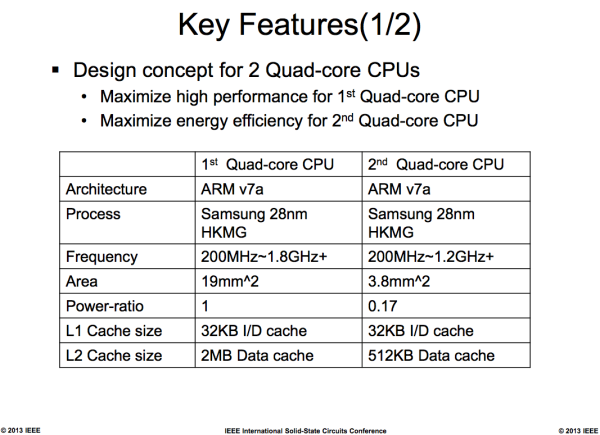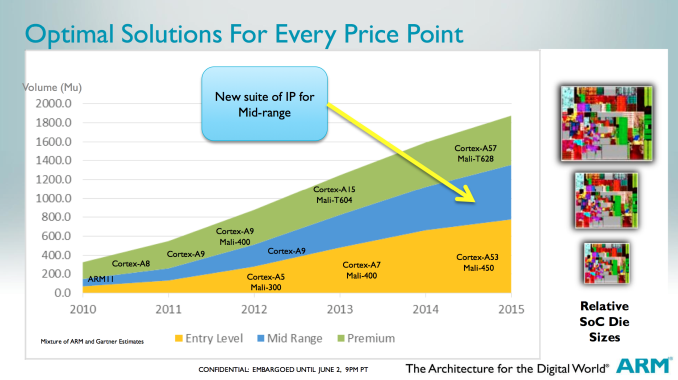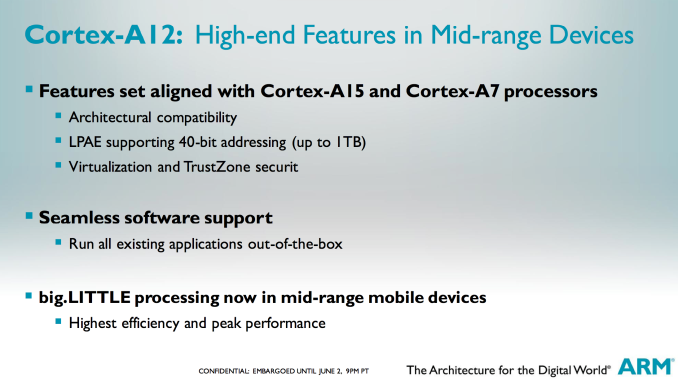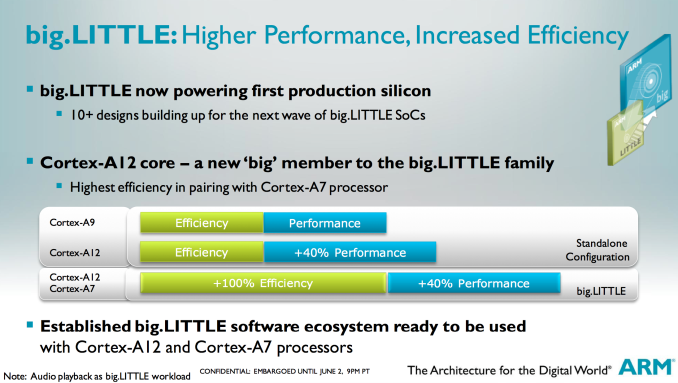ARM Cortex A12: Between Cortex A9 and A15 in Power & Perf, Sampling in Late 2014
by Anand Lal Shimpi on June 2, 2013 11:31 PM EST- Posted in
- Smartphones
- CPUs
- Arm
- Mobile
- Tablets
- Trade Shows
- SoCs
- Cortex A12
- Computex 2013

We’ve talked about the hole in ARM’s product lineup for quite a while now. The Cortex A9 is too slow to compete with the likes of Intel’s Atom and Qualcomm’s Krait 200/300 based SoCs. The Cortex A15 on the other hand outperforms both of those solutions, but at considerably higher power and die area requirements. The slide below from Samsung illustrates my point clearly:

The comparison point here is the Cortex A15 and Cortex A7, but the latter should be quite performance competitive with a Cortex A9 so the comparison is still relevant. The Cortex A15 island in Samsung’s Exynos 5 Octa occupies 5x the die area as the A7 island, and consumes nearly 6x the power. In exchange for 5x the area and 6x the performance, the Cortex A15 offers under 4x the performance. It’s not exactly an area or power efficient solution, but a great option for anyone looking to push the performance envelope.
Today, ARM is addressing that hole with the Cortex A12.
This announcement isn’t a deep architectural disclosure, but we do have some high level details to share. Like AMD’s Jaguar, Intel’s Silvermont and even ARM’s A9, the Cortex A12 is a dual-issue out-of-order architecture. Unlike the Cortex A9, the Cortex A12 is fully out-of-order including the NEON/FP units (NEON/FP was in-order on Cortex A9).
Pipeline length increased a bit compared to Cortex A9 (11 stages), however ARM told me to expect similar frequencies to what we have with the Cortex A9.
The execution back end has also been improved, although I don’t have many details as to how. My guess is we should expect something a bit wider than Cortex A9 but not nearly as wide as Cortex A15.
Memory performance is much improved compared to Cortex A9 as well, which we’ve already demonstrated as a significant weak point in the A9 architecture.
All of the architectural enhancements are supposed to provide up to a 40% increase in performance (IPC) over Cortex A9 at the same frequency and process node. ARM isn’t talking power, other than to say that it can do the same workload at the same power as a Cortex A9. In order words, Cortex A12 should have higher power than Cortex A9 but faster execution reduces total energy consumed. With a higher max power we’ll see more dynamic range in power consumption, but just not nearly as much as with the Cortex A15.
Cortex A12 also adds support for 40-bit memory addressability, an intermediate solution before we get to 64-bit ARMv8 based architectures. Finally, Cortex A12 features the same ACE bus interface as Cortex A7/A15 and can thus be used in big.LITTLE configurations with either core (but likely exclusively with the A7s). Given the lower power profile of Cortex A12, I'm not sure the complexity of doing a big.LITTLE implementation will be worth it though.
ARM expects the Cortex A12 to be used in mainstream smartphones and tablets where cost and power consumption are a bit more important. The design makes a lot of sense, the only downside is its launch timeframe. ARM expects to be sampling Cortex A12 in late 2014 with the first devices showing up in 2015. Update: ARM clarified that SoCs based on Cortex A12 would be shipping to device vendors in mid-2014, with devices shipping to consumers by late 2014 to early 2015. ARM has optimized Cortex A12 processor packs at both Global Foundries (28nm SLP) and TSMC (28nm HPM).













78 Comments
View All Comments
Klimax - Tuesday, June 4, 2013 - link
That's not everything...lmcd - Tuesday, June 4, 2013 - link
Also, isn't Jaguar faster than A15 by a pretty significant bit? Especially in floats and doubles, as noted by the recent piece on the matter.Wilco1 - Tuesday, June 4, 2013 - link
No, Jaguar is slightly faster on integer but on FP A15 beats Jaguar by a good margin: http://browser.primatelabs.com/geekbench2/compare/...kpal12 - Tuesday, June 4, 2013 - link
Cortex A15 ----> Cortex A57Cortex A9 ----> Cortex A12 -----> Cortex A55?
Cortex A7 ----> Cortex A53
Homeles - Monday, June 3, 2013 - link
Maybe I'm missing something, but isn't late 2014 too late for A12 to be relevant? Silvermont will not only be outperforming it by a wide margin, but it will also have already undergone a node advancement and will have appeared in the form of Airmont. Even at 20/22nm, A12 is not going to look great against a 14nm Atom. The Silvermont architecture's successor, presumably coming less than a year later, will only exacerbate the issue.A57 and A53 may very well be more competitive, but A12 just doesn't sound even remotely useful with that launch time frame. Won't A53 already be encroaching on A12's performance?
I suppose an A12/A7 or A12/A53 pair would make perfect sense for smartphones, but Atom will look even better...
Homeles - Monday, June 3, 2013 - link
I do suppose A12 would be a nice toy for Qualcomm and Apple to play with, though.michael2k - Tuesday, June 4, 2013 - link
Apple has Swift and Qualcomm has Krait, both of which were released in 2012 and are already similar to A12; the A12 is for the Rockchips and Mediateks who don't have the budget to develop their own SoC so that in 2014 you can get $200 smartphones with the power/battery of an iPhone 5. Apple and Qualcomm will have a 20nm part more similar to the A15 or A57 at that point.Your point wrt Atom is also behind since Atom today is barely competitive with Swift/Qualcomm, and the next gen Atom won't be out until 2014, competing against 20nm A15 parts.
Krysto - Monday, June 3, 2013 - link
22nm Silvermont won't appear until first half of 2014 in smartphones, and 14nm won't appear until 2015. Also 22nm Silvermont will be competing with the 20nm Cortex A15 and 20nm-whatever-Qualcomm-comes-up-with next year.Homeles - Monday, June 3, 2013 - link
Atom is going to be the lead uarch on Intel's 14nm process.Krysto - Tuesday, June 4, 2013 - link
Maybe, but it still won't be available in phones until 2015. Do you really think they'd release it in mid-2014, if they are barely launching Silvermont in phones in Q1-Q2 2014? At the very earliest it will be November-December 2014, but my bet is still on 2015.